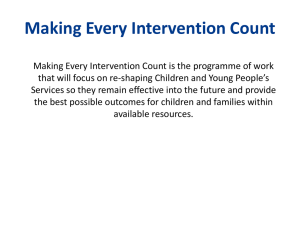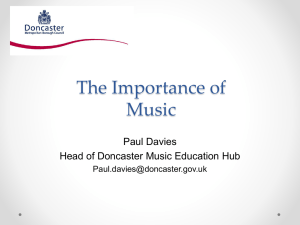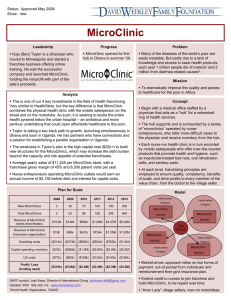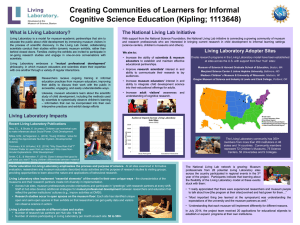Appendix D – Glossary of Terms for Distance Learning
advertisement
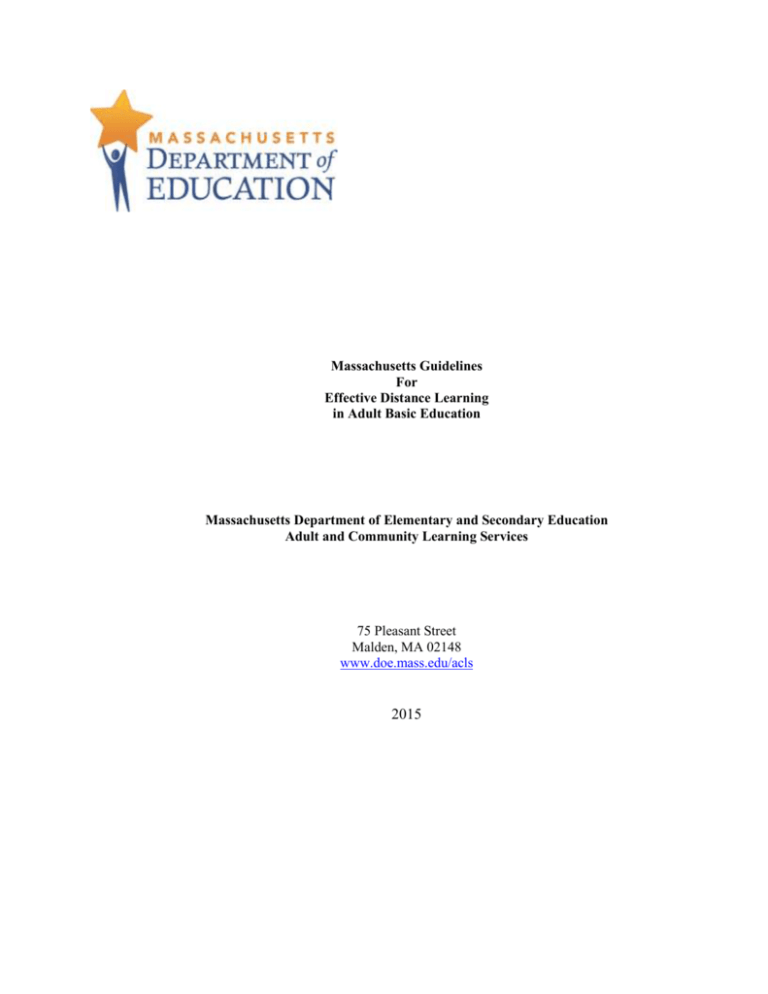
Massachusetts Guidelines For Effective Distance Learning in Adult Basic Education Massachusetts Department of Elementary and Secondary Education Adult and Community Learning Services 75 Pleasant Street Malden, MA 02148 www.doe.mass.edu/acls 2015 Table of Contents I. Introduction ...................................................................................................................................... 4 Integrating DL into the Overall CALC Program ............................................................................. 4 II. DL Model Overview ....................................................................................................................... 5 Adding New Programs to DL .......................................................................................................... 5 Hubs, CALC Option 1, and CALC Option 2 ................................................................................... 5 Hybrid Model ................................................................................................................................... 5 Student Participation ........................................................................................................................ 5 Proxy Seat Time ............................................................................................................................... 6 Direct Time ...................................................................................................................................... 6 Student Eligibility ............................................................................................................................ 6 ABE Students ................................................................................................................................... 6 ESOL Students ................................................................................................................................. 6 III. Distance Learning Curricula .......................................................................................................... 7 HiSET and pre-ASE curricula ......................................................................................................... 7 ESOL curricula ................................................................................................................................ 7 Supplemental Instruction and Support ............................................................................................. 7 Curriculum Approval Process .......................................................................................................... 7 IV. DL Hub .......................................................................................................................................... 8 Overview of the HUB ...................................................................................................................... 8 DL Hub Instruction and Student Support ........................................................................................ 8 DL Orientation: Introduction to Distance Learning for Students .................................................... 8 Staffing............................................................................................................................................. 9 Communication Protocols and Support for CALCs ........................................................................ 9 SMARTT Data Entry ....................................................................................................................... 9 Required Matching Contribution and Maintenance of Effort (MOE) ........................................... 10 Matching Contribution Requirements............................................................................................ 10 V. DL Option 1 Program ................................................................................................................... 11 Enrollment...................................................................................................................................... 11 Intake.............................................................................................................................................. 11 Screening........................................................................................................................................ 11 Orientation ..................................................................................................................................... 11 Communication with the Hub ........................................................................................................ 11 Student Support.............................................................................................................................. 11 SMARTT Data Entry ..................................................................................................................... 11 COGNOS Reports .......................................................................................................................... 12 Staff Development ......................................................................................................................... 12 VI. DL Option 2 Program .................................................................................................................. 12 Enrollment...................................................................................................................................... 12 Intake.............................................................................................................................................. 12 Screening........................................................................................................................................ 13 Orientation ..................................................................................................................................... 13 DL Instruction ................................................................................................................................ 13 Collaboration with the Hub............................................................................................................ 13 Student Support.............................................................................................................................. 13 Guidelines for Effective Distance Learning in Adult Basic Education Programs Massachusetts Department of Elementary and Secondary Education / Adult and Community Learning Services Revised 2/1/2015 2 SMARTT Data Entry ..................................................................................................................... 13 COGNOS Reports .......................................................................................................................... 14 Staff Development ......................................................................................................................... 14 Appendix A – Sample Distance Learning Student Contract ............................................................. 15 Appendix B – Tools to Evaluate Teacher and Student Readiness for Distance Learning ................. 16 Appendix C – Resource and Reference Materials ............................................................................. 16 Appendix D – Glossary of Terms for Distance Learning .................................................................. 16 Appendix E – Application for New Distance Learning Curriculum Approval ................................. 17 Guidelines for Effective Distance Learning in Adult Basic Education Programs Massachusetts Department of Elementary and Secondary Education / Adult and Community Learning Services Revised 2/1/2015 3 I. Introduction Distance Learning (DL) is a formal activity where students and instructors are separated by geography, time or both for the majority of the instructional period. Distance Learning materials are delivered through web-based programs, computer software and other online technologies. Teachers support distance learners through communication by telephone, email, texting or other technologies, and software. Hybrid learning is an instructional delivery model that incorporates distance learning activities with traditional face-to-face (F2F) classroom instruction. Integrating DL into the Overall Community Adult Learning Center (CALC) Program The primary purposes for integrating DL into the core CALC instructional program are to: Serve students in need of Adult Secondary Education (ASE) and English for Speakers of Other Languages (ESOL) services using a hybrid model for currently enrolled students in F2F classes in which students develop independent study skills and increase intensity while having regular and frequent access to F2F learning and academic support services. Increase access to services for students on a waiting list or other referral sources. Help students become college and career ready in order to reach one or more next steps, including transitioning into post-secondary education, becoming job ready, obtaining employment, and accessing occupational training. Guidelines for Effective Distance Learning in Adult Basic Education Programs Massachusetts Department of Elementary and Secondary Education / Adult and Community Learning Services Revised 2/1/2015 4 II. DL Model Overview Adding New Programs to DL Community Adult Learning Centers are funded for either Distance Learning Option 1 or Option 2. This choice determines whether DL instruction is available exclusively at the Hub (Option 1) or whether DL instruction is available at the Hub and at the Community Adult Learning Center (Option 2). All new programs are funded as Option 1. Programs with proven performance can request an upgrade to Option 2. Any change in Option status requires ACLS approval. Hubs, CALC Option 1, and CALC Option 2 The Hub is the online instruction provider. Massachusetts funds two DL Hubs. One provides ASE and Pre-ASE instruction and the other provides ESOL instruction. Option 1 - A minimum of 10 students are served. All students receive DL instruction from the Hub. Eligible students may be enrolled in traditional F2F classes at the learning center (dual enrollment) or recruited from the waiting list or other referral sources and receive all instruction online from the DL Hub or the CALC (direct enrollment). Option 2 - A minimum of 20 students are served. Students receive instruction from the learning center DL instructor and/or from the Hub. Eligible students may be enrolled in traditional F2F classes at the learning center (dual enrollment) or recruited from the waiting list or other referral sources and receive all instruction directly online from the DL Hub or the CALC (direct enrollment). Hybrid Model ACLS supports a hybrid model of distance learning that offers a combination of online instruction and F2F interaction. The features of the ACLS hybrid model are based on the following key components: Regardless of where primary DL instruction occurs, all Option 1 and Option 2 programs must provide DL students with ongoing and regularly scheduled F2F interaction for instructional support. Support may include, but is not limited to, individual tutoring, small group drop-in sessions (ESOL or HiSET subject areas), conversation groups for ESOL students, meetings at off-site locations, and other opportunities for group learning as needed. Option 2 programs may choose to establish a hybrid model class within the CALC. This type of class consists of a cohort of students enrolled in a F2F classroom with an online component taught by the DL instructor. Student Participation Students must complete 12 contact hours of orientation and have these hours recorded in SMARTT before enrollment in the DL program. In order for students to move expeditiously toward their educational goals and next steps, students must commit, by signing a student contract, to participate, on average, five hours per week or more on DL curriculum product(s) and supplemental activities. Depending on the DL curriculum product(s) used, student participation hours in the DL hybrid model must be captured under the proxy seat-time method or direct time method. Guidelines for Effective Distance Learning in Adult Basic Education Programs Massachusetts Department of Elementary and Secondary Education / Adult and Community Learning Services Revised 2/1/2015 5 Proxy Seat Time Clock Time Model - hours based on time a learner is engaged in a curriculum program that tracks actual time on task. Learner Mastery Model - fixed number of hours assigned for unit or lesson mastery based on passing a unit or lesson test. Direct Time Supplemental F2F o F2F supplemental instruction such as tutoring, workshops, mentoring, and conversation classes (which could occur in the program’s computer lab). Supplemental at a distance o Synchronous online instructor-led discussion, tutoring or webinars. o Telephone conference calls (teacher keeps a log that shows time and instructional topics discussed over the phone). o Live broadcast to remote location (facilitator/teacher keeps a log). o Online sites such as Khan Academy, Career Ready 101, and/or Reading Horizons. Student Eligibility ABE Students Students must be 16 years of age or older, not enrolled in a secondary school. Dually enrolled students must have a scaled score of at least 400 (GLE 6) in reading literacy as determined by the Massachusetts Adult Proficiency Test (MAPT). Directly enrolled DL students must have a scaled score of at least 500 (GLE 9) in reading literacy as determined by the Massachusetts Adult Proficiency Test (MAPT). ESOL Students Students must be 16 years of age or older, not enrolled in a secondary school. All DL ESOL students must have a scaled score of at least 401 (SPL 2) as determined by the BEST Plus test or a scaled score of at least 397 (SPL 2) as determined by the TABE Class-E. Guidelines for Effective Distance Learning in Adult Basic Education Programs Massachusetts Department of Elementary and Secondary Education / Adult and Community Learning Services Revised 2/1/2015 6 III. Distance Learning Curricula FY 15 approved core curricula for use in distance learning programs: HiSET and pre-ASE curricula KET Fast Forward – College and Career Ready Skills Tutor eXtra Learning Odyssey Ware ESOL curricula USA Learns Skills Tutor Rosetta Stone Supplemental Instruction and Support Instruction utilizing supplemental materials must be aligned with the Massachusetts ESOL Curriculum Frameworks and the College and Career Readiness Standards and reflect the diverse educational, cultural, and linguistic backgrounds of the students served. Supplemental instructional materials should incorporate real-life “authentic” contexts that are responsive to the needs, skills, goals, and interests of adult students in their roles as students, family members, members of the community, and lifelong learners. Khan Academy, Career Ready 101, and Reading Horizons are approved as supplements to the core curriculum. Curriculum Approval Process ACLS encourages new programs to start with a single curriculum product in their first year. Programs that would like to use an online curriculum that is not on the list must contact ACLS to seek approval. Programs may recommend additional curricula for ACLS approval by completing the application in Appendix E and emailing it to mrauh@doe.mass.edu. The ACLS Distance Learning Team will review all applications and notify programs when new curricula are approved. Guidelines for Effective Distance Learning in Adult Basic Education Programs Massachusetts Department of Elementary and Secondary Education / Adult and Community Learning Services Revised 2/1/2015 7 IV. DL Hub Overview of the HUB The Hub is the online instruction provider for students enrolled in Option 1 Community Adult Learning Centers. Some students in Option 2 Community Adult Learning Centers may also be referred to the Hub. The responsibilities of the Hub are primarily to provide distance learning instruction, collaborate with the learning centers to identify screening and orientation protocols, provide communication protocols to ensure communication between the Hub staff and the CALCs, and support learning centers in developing content for the orientation called Introduction to Distance Learning. The Hub must provide instruction for 52 weeks per year, preferably through semester courses or structural/thematic units. DL instruction provided at the Hub should reflect a balance of short courses, group and individual instruction, and synchronous/asynchronous instruction. Individualized courses of study with timedefined boundaries may be developed based on students’ needs. DL Hub Instruction and Student Support Provide instruction and academic support for students enrolled at the Hub. Record student participation data into SMARTT for students enrolled at the Hub according to proxy seat time and direct time reporting methods. Inform CALCs when students are ready for post-testing so the CALCs can schedule the post-testing with their students at participating learning centers in accordance with ACLS assessment policies. Provide instructional materials, access to curriculum, and supplemental materials to all students. Establish and support a sense of community among learners through social networking platforms. DL Orientation: Introduction to Distance Learning for Students The Instructional Hub provides content for the orientation Introduction to Distance Learning to be provided by the CALC, to introduce and familiarize students with the hybrid model used in Massachusetts. This content includes but is not limited to the curriculum used by the Hub, systems in place for communication with students, expectations for DL student participants, and an introduction to Hub teachers and staff. All distance learning students are required to complete 12 contact hours for student eligibility for federal reporting purposes prior to enrolling in the distance learning program. The components of the orientation, Introduction to Distance Learning, should include: Introduction to the hybrid model of distance learning as both a supplement to classroom instruction and as an independent mode of learning. Introduction and review of independent learning skills, time management, and communication skills. Training in the curriculum software and instruction in the curriculum product, including how to participate in and complete modules, communicate with the instructor, and ask for assistance. Introduction to computer skills necessary to work in the curriculum product, navigate the internet, use social networking platforms, and communicate via email. Any other systems used and implemented by the Hub (for students who receive instruction from the Hub). At the conclusion of the orientation Introduction to Distance Learning, all students must enter into a written contract and commit to at least five hours per week for distance learning study and instruction. Guidelines for Effective Distance Learning in Adult Basic Education Programs Massachusetts Department of Elementary and Secondary Education / Adult and Community Learning Services Revised 2/1/2015 8 Student participation may be a combination of curriculum and supplemental materials as measured by proxy seat time hours and direct (synchronous) time. Staffing It is recommended that the Hub employ three to four part-time DL teachers, who provide online instruction to students referred by the CALCs. Programs are encouraged to combine part-time DL positions with classroom teaching so that adding DL time will create full time (FT) or close to FT positions in the program, provided staff is trained and effective in distance learning instruction. DL staff will participate in professional development opportunities for DL instruction through online forums, list-servs, webinars, and other venues on a regular basis. All DL staff should participate in staff and professional development activities that are relevant to the needs of the program, community, and students served. Participation by DL Hub program staff in the following activities is required: Within the first year of the grant, all distance learning instructional and coaching staff must attend the DL Kick-off and participate in the online course Introduction to Teaching Adult Basic Education Students Online. In the second and subsequent years of the grant, all distance learning instructional staff must participate in the online course Pathways of Persistence and Providing Effective Screening. All distance learning instructional staff must be trained in the approved distance learning curriculum products (ABE or ESOL) used by the Hub. The DL Hub staff must participate in regularly scheduled conference calls and webinars with the State DL Coordinator. The DL Hub coordinator facilitates a meeting with new programs at the ACLS sponsored DL Kick-Off. The DL Hub staff must attend the annual DL Summit. Communication Protocols and Support for CALCs The Hub establishes communication protocols to ensure regular communication between the Hub staff and the CALCs to inform CALCs of their students’ progress on a monthly basis. The Hub provides content and support to the CALCs in designing the orientation called Introduction to Distance Learning. The Hub informs CALCs when students are ready for post-testing so the CALCs can schedule the posttesting with their students at participating learning centers in accordance with ACLS assessment policies. SMARTT Data Entry The Hub accepts students’ placements/referrals from DL Community Adult Learning Centers (CALCs) in SMARTT. The Hub does not enter new student intakes; all students are placed/referred to the Hub by the CALC. The Hub enrolls participating DL students in the appropriate DL curriculum. The Hub enters DL student attendance based on the current curriculum proxy seat time model (mastery or clock time model) for the curriculum used by the Hub. Guidelines for Effective Distance Learning in Adult Basic Education Programs Massachusetts Department of Elementary and Secondary Education / Adult and Community Learning Services Revised 2/1/2015 9 Required Matching Contribution and Maintenance of Effort (MOE) Recipients of ABE grants must provide fully auditable matching resources equal to at least 20% of the grant award. In each subsequent year, including the first year of a new competition, the matching contribution must be equal to the amount contributed in the previous year, or 20% of the new grant amount, whichever is greater. The matching share committed in year one of a multi-year grant cannot be reduced without the Department’s written approval. This is referred to as “maintenance of effort”. Matching Contribution Requirements Instructional and support services provided with matching funds must meet the “opportunity to learn standards” as outlined in the Massachusetts Policies for Effective ABE. Matching resources must add value to program operations, instructional, and support services. Matching resources must be fully documented, auditable, and comprised of directly allocable (not indirect) costs. Grant applications and budget forms must identify the source or sources of matching funds. ESE requires that matching resources support the DL Hub. Funds that support any portion of services provided to DL students through the DL program are good examples of match that support the DL Hub. Local cash contributions such as local ABE appropriations from cities, towns, and local educational agencies (LEAs) are an example of match if they support the DL Hub. The availability of existing computer hardware, telecommunications networks, video technology, and elements of a successful DL program through a matching contribution is preferred; however, these costs are also allowable as expenses to be charged to the grant. Guidelines for Effective Distance Learning in Adult Basic Education Programs Massachusetts Department of Elementary and Secondary Education / Adult and Community Learning Services Revised 2/1/2015 10 V. DL Option 1 Program Enrollment A minimum of 10 students are served. All students receive DL instruction from the Hub. Student intake, screening, and orientation are the responsibility of the CALC. Eligible students may be enrolled in traditional F2F classes at the learning center (dual enrollment), or recruited from the waiting list, or other referral sources and receive all instruction directly online from the DL Hub or the CALC (direct enrollment). The CALC is responsible for completing a minimum of 12 contact hours with a student prior to enrolling him/her at a DL Hub. The 12 contact hours may be a combination of intake, screening, and orientation. Intake The CALC is responsible for: Conducting outreach, recruitment, intake, enrollment, and goal setting for all DL students. Conducting pre- and post-testing for DL students in accordance with ACLS Assessment Policy and Procedures at http://www.doe.mass.edu/acls/assessment/. The initial assessment may take place at the first or second F2F meeting. Obtaining necessary release of information forms for all DL students. Screening The CALC integrates DL prescreening into the adult learning center’s established intake process. Other resources include materials that may be obtained through the ASE and ESOL Hubs (contact the Hub Coordinators for more information). See the Distance Learning Handbooks linked in Appendix C. Orientation The CALC offers its Introduction to Distance Learning orientation which is informed by the Hub on a frequent and ongoing basis. This orientation introduces cohorts of distance learning students to the hybrid mode, the curriculum and supplemental materials, ensures that essential technology skills are in place, introduces social networking tools to allow students to experience and participate in a virtual community of learners, and supports the independent study skills necessary for persistence and success in online learning. Communication with the Hub The CALC follows a communication protocol established by the Hub to share information in order to best support DL students receiving instruction from the Hub. The communication is also important so the CALC’s DL coach can follow up on student enrollment and verify student participation in the distance learning program at the Hub. Protocols can be found at http://www.sabes.org/program-support/distance-learning/ Student Support The CALC provides ongoing and regularly scheduled F2F support to DL students enrolled at the DL Hub. SMARTT Data Entry The CALC must enter student participation data into SMARTT for all DL students in a timely manner and in accordance with the ACLS Statement of Assurances. Each fiscal year, the CALC must add to the program plan the DL award of $5,000 on the Supplemental and Foundation page. Guidelines for Effective Distance Learning in Adult Basic Education Programs Massachusetts Department of Elementary and Secondary Education / Adult and Community Learning Services Revised 2/1/2015 11 The CALC records all DL Orientation hours on the DL curriculum screen. If more time is spent on orientation topics in subsequent sessions, student orientation hours in SMARTT must be revised. The CALC places/refers all the DL students to the DL Hub from the student’s record. The Hub provides all DL instruction. The CALC enrolls students for whom it provides DL instruction into the DL curriculum used by the CALC. The CALC enters all F2F supplemental and at a distance supplemental attendance for students whom it provides DL instruction. COGNOS Reports The CALC will review DL Cognos reports on a regular basis to monitor attendance and student progress in order to support students effectively. Staff Development DL staff will participate in professional development opportunities for distance learning instruction through online forums, list-serv, webinars, and other venues on a regular basis. At least two teachers must complete Teaching Adult Basic Education Students Online within the first year of participation in the project and be trained in curriculum products used by the Hub. The DL coach must participate in regularly scheduled conference calls and webinars with the State DL Coordinator. The DL coach must attend the annual DL Summit. Learning centers are encouraged to utilize program and staff development resources to support the integration of distance learning. Learning centers are encouraged to provide access to training in the approved curriculum product(s) for all teachers in order to support the integration of distance learning. The DL coach must be trained in the approved distance learning curriculum product(s) used by the Hub. In the second and subsequent years of the grant, the DL coach must be trained in Pathways of Persistence and Providing Effective Screening. These trainings are provided through the System for Adult Basic Education Support (SABES). VI. DL Option 2 Program Enrollment A minimum of 20 students are served. Students receive DL instruction from the learning center DL instructor. The CALC may also refer some DL students to the Hub. Eligible students may be enrolled in traditional F2F classes at the learning center (dual enrollment) or recruited from the waiting list or other referral sources and receive all instruction directly online from the DL Hub or the CALC (direct enrollment). The CALC is responsible for completing a minimum of 12 contact hours with a student prior to enrolling him/her in the distance learning curriculum. The 12 contact hours may be a combination of intake, screening, and orientation. Intake The CALC is responsible for: Conducting outreach, recruitment, intake, enrollment, and goal setting for all DL students. Guidelines for Effective Distance Learning in Adult Basic Education Programs Massachusetts Department of Elementary and Secondary Education / Adult and Community Learning Services Revised 2/1/2015 12 Conducting pre- and post-testing of all DL students in accordance with ACLS Assessment Policy and Procedures at http://www.doe.mass.edu/acls/assessment/. The initial assessment may take place at the first or second F2F meeting. Obtaining necessary release of information forms for all DL students. Screening The CALC will integrate DL prescreening into the adult learning center’s established intake process. See the Distance Learning handbooks listed in Appendix C. Orientation The Learning Center offers its Introduction to Distance Learning orientation on a frequent and ongoing basis. This orientation introduces cohorts of DL students to the hybrid model, the curriculum and supplemental materials, ensures that essential technology skills are in place, introduces social networking tools to allow students to experience and participate in a virtual community of learners, and supports the independent study skills necessary for persistence and success in online learning. DL Instruction Students receive DL instruction from the DL instructor hired by the CALC. The DL instructor is required to complete Teaching Adult Basic Education Students Online within the first year of teaching DL. The CALC may also refer some DL students to the Hub for DL instruction. Collaboration with the Hub Option 2 CALCs that refer some students to the Hub must collaborate and maintain ongoing communication with the Hub in order to support DL students enrolled at the Hub and ensure that these students are actively participating in the DL program. Student Support The CALC provides ongoing and regularly scheduled F2F support to all DL students. SMARTT Data Entry The CALC must enter student participation data into SMARTT for all DL students in a timely manner and in accordance with the ACLS Statement of Assurances. Each fiscal year, the CALC must add to the program plan the DL award of $10,000 on the Supplemental and Foundation page. The CALC records all DL orientation hours on the DL curriculum screen. If more time is spent on orientation topics in subsequent sessions, students’ orientation hours in SMARTT must be revised. The CALC enrolls students for whom it provides DL instruction into the DL curriculum used by the CALC. The CALC enters DL students’ attendance for the curriculum used. The CALC enters supplemental F2F and supplemental at a distance attendance for students for whom it provides DL instruction. The CALC places/refers only the DL students that are being sent to the DL Hub for instruction from the students’ information record. The CALC enters Supplemental F2F and at a distance attendance for students that attend the CALCs regularly scheduled sessions. Guidelines for Effective Distance Learning in Adult Basic Education Programs Massachusetts Department of Elementary and Secondary Education / Adult and Community Learning Services Revised 2/1/2015 13 COGNOS Reports The CALC will review DL Cognos reports on a regular basis to monitor attendance and student progress in order to support students effectively. Staff Development DL staff at the CALC will participate in professional development opportunities for distance learning instruction through online forums, list-serv, webinars, and other venues on a regular basis. At least two teachers must complete Teaching Adult Basic Education Students Online within the first year of participation in the project and be trained in curriculum products used by the Hub. The DL instructor must participate in regularly scheduled conference calls and webinars with the State DL Coordinator. The DL instructor must attend the annual DL Summit. Learning centers are encouraged to utilize program and staff development resources to support the integration of distance learning. Learning centers are encouraged to provide access to training in the approved curriculum product(s) for all teachers in order to support the integration of distance learning. The DL instructor must be trained in the approved distance learning curriculum product(s) used by the program. In the second and subsequent years of the grant, the DL instructor must be trained in Pathways of Persistence and Providing Effective Screening. Guidelines for Effective Distance Learning in Adult Basic Education Programs Massachusetts Department of Elementary and Secondary Education / Adult and Community Learning Services Revised 2/1/2015 14 Appendix A – Sample Distance Learning Student Contract (Last Name) (First Name) (Middle Initial) The (program name) is a supportive community that encourages and assists students in pursuing educational, career, and higher education goals. All individuals enrolling in distance learning will participate and complete Introduction to Distance Learning (DL Orientation). Individuals must agree to adhere to the following terms in order to participate in the distance learning program. All students must complete all work in a timely and appropriate manner. A minimum of five hours of studying per week is required. Adhere to the learning center policies for computer usage. Maintain appointments with the instructor. Maintain weekly contact with the instructor by phone, email, or in person. Notify staff if you will be late for, or unable to keep appointments. Complete all assessments including all pre- and post-tests. Return (if in possession of) all loaned software at the completion of the program and/or at the request of the learning center. Check off if you agree to the following optional term: □ I agree to the use of photographs, videos, and quotations of me/or my child or ward (if under 18), in accounts or promotions of Distance Learning. In signing this contract, you agree to accept the terms outlined above. ____________________________________________ Student’s Signature ___________ Date ____________________________________________ Parent/Legal Guardian Signature (if student is under 18) ___________ Date Guidelines for Effective Distance Learning in Adult Basic Education Programs Massachusetts Department of Elementary and Secondary Education / Adult and Community Learning Services Revised 2/1/2015 15 Appendix B – Tools to Evaluate Teacher and Student Readiness for Distance Learning The following link will connect you to the Project Ideal web site and the Handbook of Distance Learning for Adult Learners, Fourth Edition by Leslie Petty and Jerome Johnson, Project IDEAL Support Center at the Institute for Social Research at the University of Michigan. This document contains a number of resources to assist you in developing your plans for recruiting and teaching adults at a distance. http://projectideal.org Appendix C – Resource and Reference Materials Distance Learning handbooks developed for ACLS by the UMass Boston, Center for Social Policy, June 2009, updated by ACLS 2014: Handbook of Screening, For Instructors and Administrators of Online ESOL Programs Handbook of Screening, For Instructors and Administrators of Online High School Equivalency Programs Handbook of Support, For Instructors and Administrators of Online ESOL Programs, For Supporting Students for Persistence and Success Handbook of Support, For Instructors and Administrators of Online High School Equivalency Programs, For Supporting Students for Persistence and Success Appendix D – Glossary of Terms for Distance Learning eLearners Glossary: http://www.elearners.com/guide/faq-glossary/glossary/ Guidelines for Effective Distance Learning in Adult Basic Education Programs Massachusetts Department of Elementary and Secondary Education / Adult and Community Learning Services Revised 2/1/2015 16 Appendix E – Application for New Distance Learning Curriculum Approval Massachusetts Department of Elementary and Secondary Education Adult and Community Learning Services Application for New Distance Learning Curriculum Approval Please submit this form to Mary Rauh at mrauh@doe.mass.edu The Distance Learning Team will then review the application and make recommendations for approval. Name of Adult Education Program: Date submitted: Name of Director: Name of Coordinator (or name of staff member who will oversee curriculum): Email address of Director: Email address of Coordinator: Telephone of Director: Telephone of Coordinator: Publisher: New Curriculum for Approval Curriculum Basic Information – Curriculum Model Curriculum Product name: Contact name: Address: Telephone: E-mail address: Web site: Clock Time Model – (online or stand-alone software programs that track time that student is engaged with the curriculum and which log out students after a predetermined period of inactivity) Teacher Verification Model – (multi-media instruction from a variety of sources, fixed contact hours where the teacher determines if the assignment was completed) Learner Mastery Model –(mastery of instructional content which is connected to the assignment of proxy hours, assigns a fixed number of hours based on the learner passing a test on the content of each lesson) Adapted from “Handbook of Distance Education for Adult Learners” Project Ideal, 2008 Guidelines for Effective Distance Learning in Adult Basic Education Programs Massachusetts Department of Elementary and Secondary Education / Adult and Community Learning Services Revised 2/1/2015 17 Recommended Number of Proxy Contact Hour Credits Clock time model: How will time be tracked? How will time be recorded? Teacher verification model: Who will make the determination? How many proxy hours should be awarded and how? Learner mastery model: What needs to be mastered? At what level of achievement? How many proxy hours should be awarded? NRS Levels This curriculum covers the NRS Levels (Check all that apply) ABE/ASE ESL ____Beginning Literacy ABE ____Beginning Literacy ESL ____Beginning ABE ____Low Beginning ESL ____Low Intermediate ABE ____High Beginning ESL ____High Intermediate ABE ____Low Intermediate ESL ____Low ASE ____High Intermediate ESL ____High ASE ____Advanced ESL Audience/Content 1. What audience does the curriculum serve? 2. What instructional content does the curriculum deliver? Curriculum Components (Check all that apply) ______ Online/Website ______ Stand-alone software Other_____________________ ______ Workbooks ______ Videos/DVDs Other_____________________ Curriculum Coverage Briefly explain how comprehensive the product is in its coverage of the material. Approximate cost per student $ Cost Approximate cost per program $ Is there a local or state license involved for this curriculum? State license Local license Licensing cost Yes Yes No No Period covered by license Guidelines for Effective Distance Learning in Adult Basic Education Programs Massachusetts Department of Elementary and Secondary Education / Adult and Community Learning Services Revised 2/1/2015 18 Other information about cost or pricing: Impact/effectiveness with adult students: Research/Evidence Please provide evidence such as links or supporting material from the publisher or from other users that indicate the program is research-based or how the program was developed and what research was used when creating the applications. Is this curriculum on other states’ lists of approved programs? If so, which ones? Content Standards Support Describe how the curriculum supports the College and Career Readiness Standards for Adult Education Ease and Usability Describe the ease of use for the learner and how instructors can follow the student and provide feedback and assistance. Professional Development/Training Is training provided with the curriculum? If yes, who will provide the training? Briefly describe training for the curriculum and ongoing professional development for staff. Adapted from forms developed by the Rhode Island Adult Education Technology Advisory Committee Guidelines for Effective Distance Learning in Adult Basic Education Programs Massachusetts Department of Elementary and Secondary Education / Adult and Community Learning Services Revised 2/1/2015 19
